Impact of Teamwork Effectiveness on Employee Motivation in Enrichment Centre at Malaysia
A questionnaire on the impact of teamwork on employee motivation in Malaysia, including demographic questions and survey statements to rate on a scale of 1 to 5. Also includes a literature review on factors affecting e-business successful implementation among SMEs in Malaysia and a chapter 2 of an MBA main project on the impact of team work effectiveness on employee motivation in an enrichment centre in Malaysia.
Added on 2023-06-10
About This Document
Impact of Teamwork Effectiveness on Employee Motivation in Enrichment Centre at Malaysia
A questionnaire on the impact of teamwork on employee motivation in Malaysia, including demographic questions and survey statements to rate on a scale of 1 to 5. Also includes a literature review on factors affecting e-business successful implementation among SMEs in Malaysia and a chapter 2 of an MBA main project on the impact of team work effectiveness on employee motivation in an enrichment centre in Malaysia.
Added on 2023-06-10
Motivation in Enrichment Centre at Malaysia
Table of Contents
2.0 Literature Review.. 3
2.1 Definition of Key Concepts. 3
2.1.1 Teamwork. 3
2.1.2 Motivation. 4
2.1.3
Leadership..........................................................................................3
2.1.4
Communication....................................................................................3
2.1.5 Team Trust.........................................................................................3
2.1.6 Recognition & Reward...........................................................................
3
2.2 Critical Review of Teamwork theories and models. 6
2.2.1 Tuckman Theory. 6
2.2.2 Belbin’s Model 7
2.2.3 T7 Model 8
2.2.4 GRPI Model 9
2.2.5 Heckman Model 11
2.2.6 The Lafasto and Larson Model 12
2.3 Empirical studies. 13
2.3.1 Empirical studies in Malaysia. 13
2.3.2 Empirical studies Global 15
2.4 Conceptual Framework..............................................................................18
2.4.1 Leadership & Employee
Motivation...........................................................19
2.4.2 Communication & Employee
Motivation.....................................................19
2.4.3 Team Trust & Employee
Motivation..........................................................19
2.4.4 Communication & Employee
Motivation....................................................19
Reference List 19
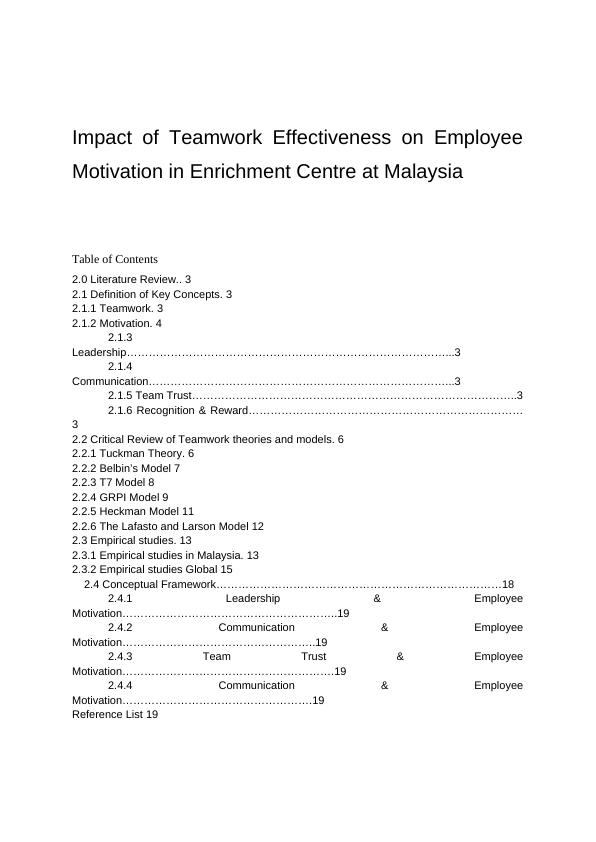
2.1 Definition of Key Concepts
2.1.1 Teamwork
Hu and Liden (2015) opined that teamwork is the collaborative effort of a team towards
achieving a common goal or completing a particular task in efficient and effective manner.
The members of a team work interdependently towards achieving the common goals of the
team. Moreover, teamwork presents the context, where group of people work together in
collaboration with each other for achieving the common organizational goals. Teamwork is
the practice of working collaboratively with a group of employees for achieving common
organizational goals. Moreover, in teamwork, the team members work in collaboration with
each other and have their interdependence on each other. However, Choi, Kim and Kang
(2017) argued that despite of interdependence, the team members must have their individual
skills for better achieving the organizational goals in unique way. Weer, DiRenzo and
Shipper (2016) stated that teamwork is the joint activities by the group of people in which
the individual interest of the employees is subordinated into group efficiency and unity and
harmonized effort. Moreover, the individual skills and strengths of the individual team
members are joined together with shared goal for achieving the overall team goal.
Dong et al. (2015) opined teamwork is the cooperation among the group of employees,
which is intended towards sharing the ideas and skills for achieving the common
organizational goals. However, the willingness of the employees to cooperate with each
other stems from the relationship of the team members with each other. Barrick et al.
(2015) teamwork is the coordinated and cooperative effort on the part of a group of
employees, who work together as a team and through the interest of common cause.
However, teamwork needs that all the workers in a team put fair and adequate share to the
workload towards accomplishing the common goals of their organization or association.
Howard,Turban and Hurley (2016) mentioned that teamwork at the workplace is the joint
efforts of the employees, who work collaboratively cohesively for creating a positive
atmosphere at the workplace for achieving common organizational goals. The support of the
team members for each other is highly dependent on their relationship and individual skills.
Costa, Passos and Bakker (2015) teamwork is a collaborative working practice, where the
individual employees work together in highly cooperative working environment for achieving
the common organizational goals through sharing skills and knowledge. Such cooperative
working practice allows the ordinary employees to achieve some extra-ordinary work goal.
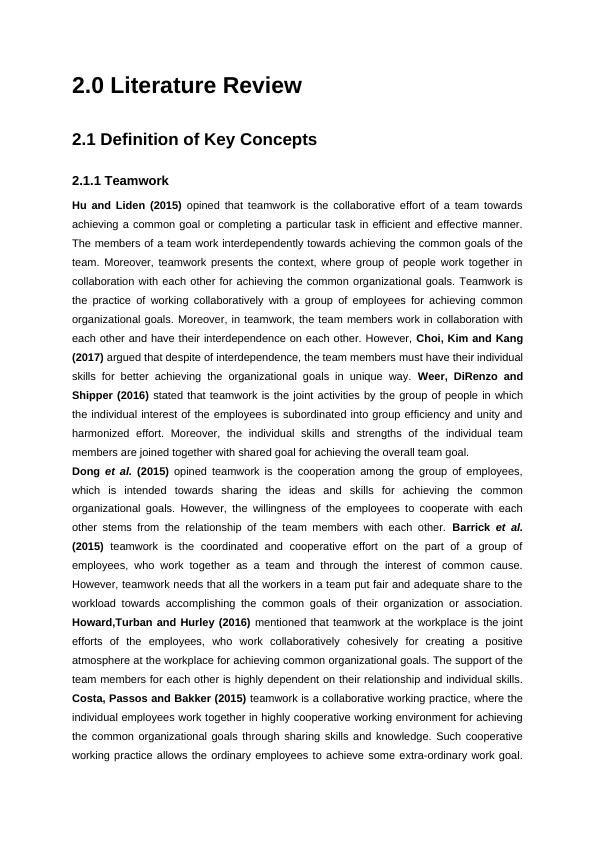
into the group efforts for achieving the broader perspectives of overall organizational goals.
The team members must have adequate skills and capabilities and their interaction with
each other should be flexible for achieving the team goals.
Sommer, Howell and Hadley (2016) pointed out that teamwork is the joint effort, where a
distinguishable set of employees interact with each other interdependently, dynamically and
adaptively for achieving common organizational goals. However, the effectiveness of
teamwork requires willingness of the team members to share their ideas and skills with each
other’s. Lin, Wu and Ling (2017) opined that teamwork is the interdependent acts of the
team members, which converts inputs into outputs through verbal, behavioral and cognitive
activities directed towards achieving common organizational goals. However, team members
require proper communication among each other for achieving common goals.
2.1.2 Motivation
Li, Chiaburu and Kirkman (2017) stated that motivation defines the external and internal
factors, which stimulate the energy and desire of the employees to be continually committed
and interested in a job role for attaining the job goals. Moreover, it becomes the reason for
acting and behaving in a particular way. Kanfer and Chen (2016) pointed out that motivation
acts as the stimulator for the needs, desire and action of the people, which stimulates the
employees to behave in a particular manner and encourage the employees to repeat the
behavior. It is generally resulted from both unconscious and conscious factors like intensity
of needs, incentives of goals and expectation of individuals and their peers. Anitha and
Begum (2016) stated that motivation is the process that initiates with psychological and
physiological deficiency or need, which activates or drives the behavior towards a goal. It is
always internal to the employees and it is externalized through their behavior. Wang,
Waldman and Zhang (2014) pointed out that motivation is the willingness of the employees
towards exerting high levels of efforts for meeting organizational goals as well as satisfying
some individual needs. It stimulates the willingness among the employees towards
performing some behaviors in a specific manner. Moreover, motivation enhances the
enthusiasm within the employees towards achieving any particular goal.
According to Boxall, Hutchison and Wassenaar (2015), motivation is the outcome of the
processes, external and internal to the individual, which arouses persistence and
enthusiasm among the employees for pursuing some source of actions. The process of
motivation stimulates the employees towards initiating a particular action. Furthermore, the
factors of motivation become the reasons for behaving in a certain way. Grille, Schulte and
Kauffeld (2015) mentioned that motivation creates willingness among the employees
towards performing at the best of their abilities. However, the stimulus must be aroused for
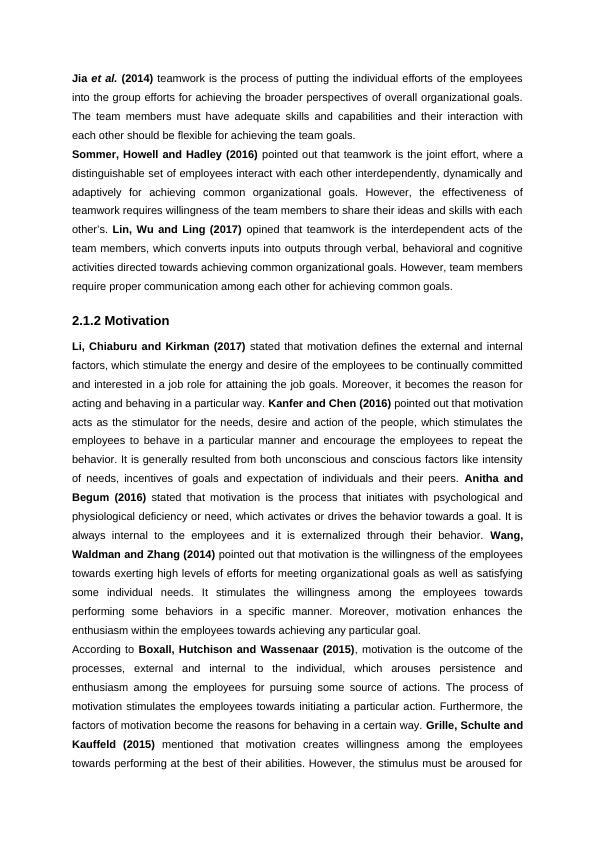
or force, which causes the employees to do some works. As per Idris, Dollard and Tuckey
(2015), motivation is the level of desire that an employee feels to perform a particular job
regardless of their level of happiness. The employees, who are highly motivated, can be
highly productive and engaged in their job role. Hence, motivation drives the employees to
work at their best for achieving overall organizational goals. Bai, Lin and Li (2016) stated
that motivation is the psychological phenomenon within the employees that encourage the
employees towards initiating a particular action. It is simply the willingness of the employees
towards exerting best effort for accomplishing any particular job. von Bonsdorff Et al.
(2015) opined that motivation is the inner state of the individuals’ minds that direct and
activates certain behaviors. The process of motivation instigates, maintains and guides goal
oriented behaviors within the employees. Kim, Pathak and Werner (2015) mentioned that
motivation is the desire, incentives and ambitions, which pushes the employees to take
certain action, performing work and accomplishing goals. However, the desires and
incentives often depend on external stimulators.
2.1.3 Leadership
Bolden, (2016) suggested that, Interdependence of employees and leader bring forward the
actual aspects of leadership as needed. It is to make sure that there is proper attested
application for every concerned objectivity presented by the management of an organisation
which will in the end result in the betterment of the organisation and the society.
There are situation in organisations which are needed to be handled with care in order to
make sure that the organisational workers get to their objectivity as a whole for a successful
organisational work. Keeping in context with the views of Maxwell (2018) it is seen that he
described leader primarily in three important position.
1. “A great leader’s courage to fulfill his vision comes from passion, not position.” John
C. Maxwell
2. “Leadership is not about title, position or flowchart. It is about one life influencing
another.” John C. Maxwell
3. “All there is one who knows the way, goes the way and shows the way” John C.
Maxwell
In general context of competitive organisations all around society in providing of fascinating
idea to understand the importance of those define leadership. Jamal and Abu Bakar, (2017)
inferred that, every aspect of Organisation in society have made clear that without leadership
there cannot be enough opportunity gained by the general workers in the context. Leaders in
society as well as an organisation do not become a leader suddenly. King, (2013) evaluated
thatTo become a leader and proposes to leadership quality one must be clear enough to
understand his need as well as his reviews for the development of the organisation or any
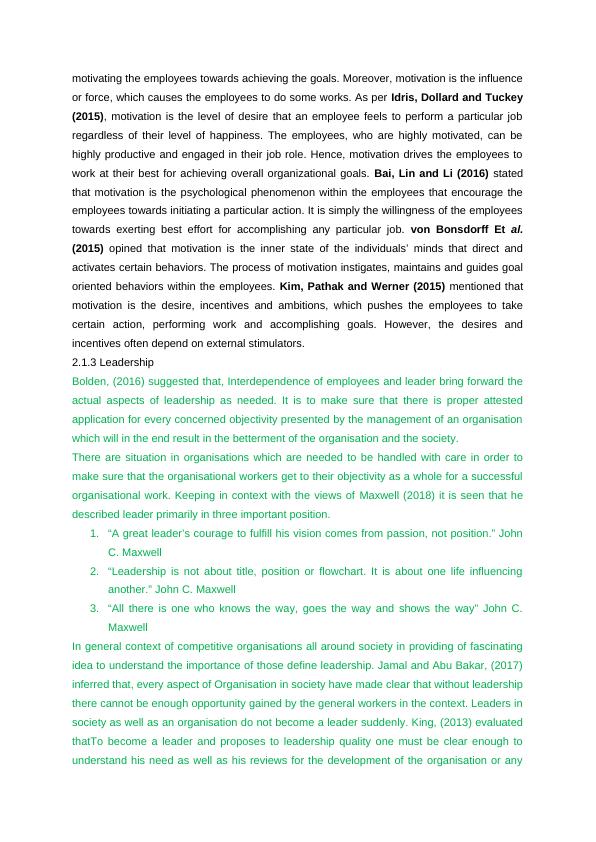
and organisations is not only to guide the employees to their expected position, but also to
understand that it is the leader who has the sole understanding of effectiveness and
efficiency in work environment.
2.1.4 Communication
As supported by Abu Bakar and McCann (2016), the aspect of the communication relates to
the two way process of reaching to a mutual understanding over decision made in
conversation with effectiveness. Exchanging of the information, news and facts related to a
general context is called communication. The communications in response to the
organisations in society are somewhat similar. Mahomed and Shah, (2015) in their article
said that, it is seen that that in organizational communication there is sending, receiving and
executing ideas presented from one end to another. The organizational communication and
other facts of communication can be verbal, Non verbal and behavioral. Any form of
communication plays and important role in the management ot make the effective work of
the organization come to play. Without communication organization and society or two
people become unaware of the general context resulting in the worse decision making
procedure.
Daud et al. (2018) inferred that the concept of organizational communication didn't came into
large focus until the year 1950, when there was an urgent need of making information and
the other facts in the organization clear to every members working with ultimate
effectiveness.
Making creativity and adaptation procedure possible is one of the important aspects
presented by the communication in every context. It is seen that the management which
uses the communication theory and other sense of communication with each other are more
effective in procuring their objectives. As per the view of Bakar et al. (2014), to build a proper
interactive environment is also seen as one of the objective of communication in
organization and therefore we can say that social world is dependent on how well
communication can be presented. Providing of instruction to the management workers from
the top level managers are placed in the hand of the people who are effective
communicators. Saad and Majid (2014) presented in their article that, communication in
whatever context it is seen, present its aura of importance towards success both directly and
indirectly
2.1.5 Team Trust
Trust seems to the one that makes every work in organization and society run without
complexity. It is the trust has brought forward opportunity to make work done with minimum
extension of time. In general context we observe that opportunity and work dimension are
directly related to trust among each other. Pangil and Moi Chan (2014) in their article that the

the team trust is not something that can be provided with initial stage of operation. It must be
inculcated in the tea by the initiative of the leaders.
Ahmad et al. (2017) suggested that aspect of team trust is seen as collective effort for the
greater good of the organization and making successful operation possible for long run.
Contribution, views and ideas are valued by the team members when there is a sense of
trust among them. Confidence increase with the support of team trust minimising the fears of
back bitching, tantrums of not working and undermining of others.
Respect among the employees, workers and members of an organization are positively
impacted by the mending of team trust. In their article Kassim and Nor (2017), inferred that
to recognise the exact skill and to provide importance to that skill there must be team trust
which allows a sense of respect on the skill possessed by others in the team and ion the
organisation.
Trivisonno and Barling, (2016) in their article that the overall importance of team trust can be
seen in the process of managing the workforce in the society. There are opportunities where
it is seen that the team trust make clear indication over the development of the workplace
strength in the field of morale. Yee et al. (2015) inferred in their article that, the team trust in
the society and organisation has positive impact over the development of satisfaction among
members. The turnover in the organization therefore goes down with every bit of increase in
the team trust.
2.1.6 Recognition & Reward
Mohd Din et al. (2017) in their work presented that monetary consideration or anything in
excess of the actual amount that is expected by one is always appreciated. Considering the
fact that every organisation has employees who deserve something in return out of their
extreme work routine, recognition and reward plays an important role. In very general it may
seem that recognition and reward are both similar, but there is a huge gap between both
term. Yee (2018) in his article consider that, keeping aside the differences between the
meaning of reward and recognition we see that the objective of both the form of motivation
relates to the development and safeguarding of employee satisfaction level.
By understanding tangibility of reward we see that monetary confirmation through a specific
amount remains to be the prime example. On the other hand recognition is intangible where
the nature of providing the knowledge about one person in front of others proves to be
priceless in value. As supported by Liyana and Khalil (2015), organisation and Society profile
recognition in order to make sure that the employees get to understand that they are being
made example in front of other organisational what caused due to their work performance.
With the kind attitude by the management towards the employees the organisation can make
sure that other members aim towards the recognition resulting in increase of the productivity.
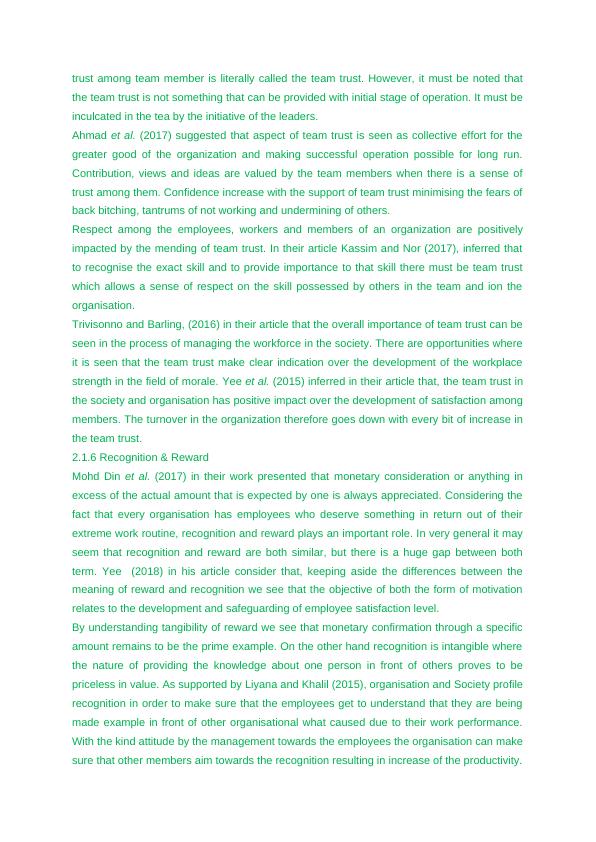
End of preview
Want to access all the pages? Upload your documents or become a member.
